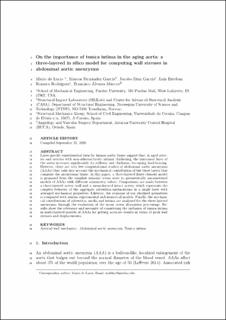| dc.contributor.author | de Lucio, Mario | |
| dc.contributor.author | Fernandez, Marcos | |
| dc.contributor.author | Diaz, Jacobo | |
| dc.contributor.author | Romera, Luis Esteban | |
| dc.contributor.author | Álvarez Marcos, Francisco | |
| dc.date.accessioned | 2021-10-25T10:39:31Z | |
| dc.date.available | 2021-10-25T10:39:31Z | |
| dc.date.created | 2020-11-25T11:07:35Z | |
| dc.date.issued | 2020 | |
| dc.identifier.issn | 1025-5842 | |
| dc.identifier.uri | https://hdl.handle.net/11250/2825289 | |
| dc.description.abstract | Layer-specific experimental data for human aortic tissue suggest that, in aged arteries and arteries with non-atherosclerotic intimal thickening, the innermost layer of the aorta increases significantly its stiffness and thickness, becoming load-bearing. However, there are very few computational studies of abdominal aortic aneurysms (AAAs) that take into account the mechanical contribution of the three layers that comprise the aneurysmal tissue. In this paper, a three-layered finite element model is proposed from the simplest uniaxial stress state to geometrically parametrized models of AAAs with different asymmetry values. Comparisons are made between a three-layered artery wall and a mono-layered intact artery, which represents the complex behavior of the aggregate adventitia-media-intima in a single layer with averaged mechanical properties. Likewise, the response of our idealized geometries is compared with similar experimental and numerical models. Finally, the mechanical contributions of adventitia, media and intima are analyzed for the three-layered aneurysms through the evaluation of the mean stress absorption percentage. Results show the relevance and necessity of considering the inclusion of tunica intima in multi-layered models of AAAs for getting accurate results in terms of peak wall stresses and displacements. | en_US |
| dc.language.iso | eng | en_US |
| dc.publisher | Taylor & Francis | en_US |
| dc.title | On the importance of tunica intima in the aging aorta: a three-layered in silico model for computing wall stresses in abdominal aortic aneurysms | en_US |
| dc.type | Peer reviewed | en_US |
| dc.type | Journal article | en_US |
| dc.description.version | acceptedVersion | en_US |
| dc.rights.holder | This is the authors' accepted manuscript to an article published by Taylor & Francis. | en_US |
| dc.source.journal | Computer Methods in Biomechanics and Biomedical Engineering | en_US |
| dc.identifier.doi | 10.1080/10255842.2020.1836167 | |
| dc.identifier.cristin | 1852117 | |
| cristin.ispublished | true | |
| cristin.fulltext | postprint | |
| cristin.qualitycode | 1 | |
